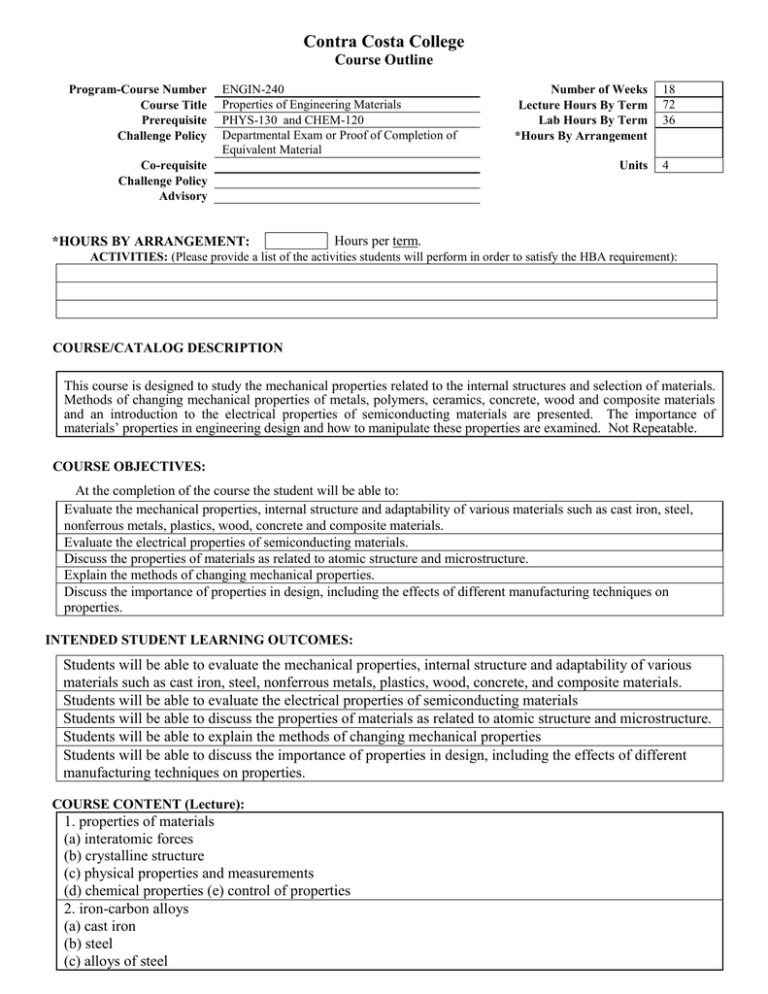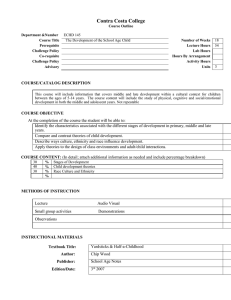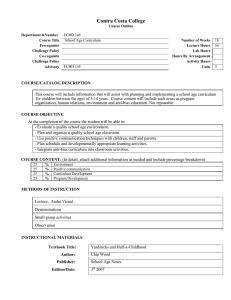
Contra Costa College
Course Outline
Program-Course Number
Course Title
Prerequisite
Challenge Policy
ENGIN-240
Properties of Engineering Materials
PHYS-130 and CHEM-120
Departmental Exam or Proof of Completion of
Equivalent Material
Co-requisite
Challenge Policy
Advisory
*HOURS BY ARRANGEMENT:
Number of Weeks
Lecture Hours By Term
Lab Hours By Term
*Hours By Arrangement
Units
18
72
36
4
Hours per term.
ACTIVITIES: (Please provide a list of the activities students will perform in order to satisfy the HBA requirement):
COURSE/CATALOG DESCRIPTION
This course is designed to study the mechanical properties related to the internal structures and selection of materials.
Methods of changing mechanical properties of metals, polymers, ceramics, concrete, wood and composite materials
and an introduction to the electrical properties of semiconducting materials are presented. The importance of
materials’ properties in engineering design and how to manipulate these properties are examined. Not Repeatable.
COURSE OBJECTIVES:
At the completion of the course the student will be able to:
Evaluate the mechanical properties, internal structure and adaptability of various materials such as cast iron, steel,
nonferrous metals, plastics, wood, concrete and composite materials.
Evaluate the electrical properties of semiconducting materials.
Discuss the properties of materials as related to atomic structure and microstructure.
Explain the methods of changing mechanical properties.
Discuss the importance of properties in design, including the effects of different manufacturing techniques on
properties.
INTENDED STUDENT LEARNING OUTCOMES:
Students will be able to evaluate the mechanical properties, internal structure and adaptability of various
materials such as cast iron, steel, nonferrous metals, plastics, wood, concrete, and composite materials.
Students will be able to evaluate the electrical properties of semiconducting materials
Students will be able to discuss the properties of materials as related to atomic structure and microstructure.
Students will be able to explain the methods of changing mechanical properties
Students will be able to discuss the importance of properties in design, including the effects of different
manufacturing techniques on properties.
COURSE CONTENT (Lecture):
1. properties of materials
(a) interatomic forces
(b) crystalline structure
(c) physical properties and measurements
(d) chemical properties (e) control of properties
2. iron-carbon alloys
(a) cast iron
(b) steel
(c) alloys of steel
3. non-ferrous metals
(a) mining, preparation, and alloying
(b) types
(c) uses
4. non-metallic inorganic materials
(a) stone
(b) ceramics, glass
(c) Portland cement and concrete
5. organic materials
(a) plastics
(b) wood
(c) rubber
(d) asphalt and asphaltic concrete
6. synthetic composite materials
(a) types
(b) processing
(c) properties
7. environment effects
(a) corrosion
(b) oxidation
(c) radiation
8. electrical and optical properties
(a) conductivity
(b) semiconductors
(c) light emission and absorption
(d) optical fibers
COURSE CONTENT (Lab):
1. Error Propagation and Uncertainties
2. Computational Modeling of Bonding of Solids
3. Computational Modeling of X-Ray Diffraction
4. Tensile Testing
5. Brinell Hardness Testing
6. Thermal Properties (Heat Capacity/Thermal Expansion)
7. Impact Testing
8. Torsion Testing
9. Jominy End Quench I (End Quench Testing)
10. Jominy End Quench II (Rockwell Hardness Testing)
11. Solar Cells
12. Composite Materials
METHODS OF INSTRUCTION:
Classroom presentation includes lecture and demonstration.
Laboratory experiments.
Field trips taken when circumstances permit.
INSTRUCTIONAL MATERIALS:
NOTE: To be UC/CSU transferable, the text must be dated within the last 7 years OR a statement of justification for a text beyond the
last 7 years must be included.
Textbook Title:
Author:
Publisher:
Edition/Date:
Textbook Reading Level:
Justification Statement:
Lab Manual Title
Author:
Publisher:
Edition/Date:
Introduction to Materials Science for Engineers
James Shackelford
Pearson Prentice Hall
7th Edition / 2009
(For textbook beyond 7 years)
Contra Costa College Engineering 240 Lab Manual
Wieber, D., et al
Contra Costa College Bookstore
Spring 2014
OUTSIDE OF CLASS WEEKLY ASSIGNMENTS:
Title 5, section 55002.5 establishes that a range of 48 -54hours of lecture, study, or lab work is required for one unit of credit.
For each hour of lecture, students should be required to spend an additional two hours of study outside of class to earn one
unit of credit.
State mandates that sample assignments must be included on the Course Outline of Record.
Outside of Class Weekly Assignments
Hours per week
Weekly Reading Assignments (Include detailed assignment below, if applicable)
2-3
Read Chapter 2: Atomic Bonding, pages 22-57
Weekly Writing Assignments (Include detailed assignment below, if applicable)
4
Ch 2 Problems: 2.1, 2.3, 2.8, 2.14,2.16, 2.17
Weekly Math Problems (Include detailed assignment below, if applicable)
Lab or Software Application Assignments (Include detailed assignment below, if applicable)
2
Lab reports for the week’s lab.
Other Performance Assignments (Include detailed assignment below, if applicable)
STUDENT EVALUATION: (Show percentage breakdown for evaluation instruments)
Course must require use of critical thinking, college-level concepts & college-level learning skills.
For degree credit, course requires essay writing unless that requirement would be inappropriate to the course objectives. If writing
is inappropriate, there must be a requirement of problem-solving or skills demonstration.
% Essay (If essay is not included in assessment, explain below.)
65
17.5
17.5
% Computation or Non-computational Problem Solving Skills
% Skills Demonstration
% Objective Examinations
Other (describe)
% Lab Reports
% Homework Assignments
%
GRADING POLICY: (Choose LG, P/NP, or SC)
Pass / No Pass
X Letter Grade
90% - 100% = A
80% - 89% = B
70% - 79% = C
60% - 69% = D
Below 60% = F
70% and above = Pass
Below 70% = No Pass
Student Choice
90% - 100% = A
80% - 89% = B
70% - 79% = C
60% - 69% = D
Below 60% = F
Percentages vary from instructor
to instructor
or
70% and above = Pass
Below 70% = No Pass
Prepared by: Jon Celesia and Mark Wong
Date: Spring 2014
Revised form 10/13






